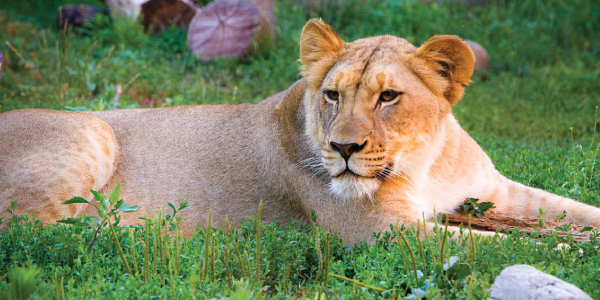
|
You can meet at the Racine Zoo:
|
Azizi, Female, born July 28, 2011
Zuri, Female, born July 7, 2014
|
|
Location at the Racine Zoo:
|
In the Vanishing Kingdom/Great Cat Canyon
|
| Scientific Name: |
Panthera leo |
| Conservation Status: | Vulnerable |
| Lifespan: | Average of 15 years in the wild, but can live upwards of 30 years in human care |
| Adult Size: | Average height is 3 ft; can be 7 to 10 ft long and can weigh up to 600 lb |
| Diet in the Wild: | Large mammals including hooved ungulates, birds, rodents, ostrich eggs |
| Diet in the Zoo: | Specialized meatballs |
| Habitat: | Plains or savannah |
| Range: | Found in most of Sub-Saharan Africa except in desserts and rainforests |
| Threats: | The main threats to lions are indiscriminate killing (primarily as a result of retaliatory or pre-emptive killing to protect human life and livestock) and prey base depletion. |
Fun Facts:
-
A lion’s roar can be heard from 5 miles away. Lions sleep up to 20 hours a day! Lionesses prefer males with a darker mane.
-
African lions are one of the only cats that live in social groups – called prides. A pride usually consists of 1-7 males, a group of upwards of 30 related females and their offspring, and a few juvenile males. Juvenile males are kicked out at around 1 ½ -2 years of age.
-
Males patrol the territory and protect the pride from competition and invading male lions. Females take part in raising each other’s cubs as well as their own. Female lions work together to bring down large prey via ambush tactics, but males usually eat first.
-
Though the lion is the top predator in the savannah, it does face some competition with hyenas and other animals. Lions have been known to actively kill hyenas and vice versa.
Conservation Messages:
-
Farmers in Africa often use chemical pesticides on their crops. Herbivores in the area graze on the treated plants and become poisoned by the chemicals. Those herbivores are then hunted by the lions and as a result, the lions are harmed by the chemicals as well. Use natural pesticides on your garden, crops, and lawn to prevent bioaccumulation such as this from happening – it happens to our raptors from poisoning mice and other small rodents as well!










